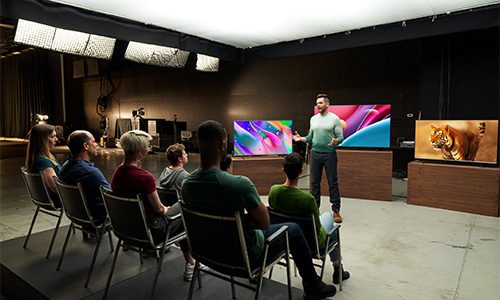Hisense, one of the fastest growing TV brands in North America, just launched a new campaign that aims to get “seriously real” about marketing. The campaign titled, “Less Talk, More TV” features seasoned Hisense brand ambassador, Joel McHale, on a mission to introduce the brand to shoppers bombarded by companies with “bloated budgets and boastful brand blurbs”.
In the “Less Talk, More TV” campaign McHale plays a passionate, delightfully blunt moderator who interacts with real people who haven’t heard of Hisense, and lets them experience the brand’s TVs in-person. The spot features a healthy dose of self-awareness, with McHale taking stabs at the brand’s marketing spend saying, “Hisense has the worst marketing budget in the industry. They spend all their money making awesome TVs, not paying advertisers to come up with stupid slogans”.
McHale goes on to poke fun at the “blockbuster-level” special effects used by some TV brands to demonstrate their features, but then considers maybe Hisense’s approach is a good thing, “because you wind up with a TV that’s as good, and usually better, than any competitor in their class”.
In addition to its “Less Talk, More TV” marketing Campaign, the company notes that in 2021, Hisense states that ULED TV unit sales grew 170 percent year-once-year, and it had its most award-winning year to date with more than 20 awards. Hisense was also named the fastest growing among the top five TV brands and grew its share within the premium category by increasing U.S. unit sales in the 65-inches and above category by 41% year on year.
The “Less Talk, More TV” campaign, which will run through mid-July utilizing high impact placements on Connected TV and BVOD, supported by Paid Social and Digital Display, is accompanied by the brand’s first ever Brand Survey, or “BS” Report, which surveyed 2,500 U.S. adults earlier this year. The “BS” report highlighted the fact that most consumers wish brands would spend fewer resources on advertising. In fact, 86 percent of consumers agree they’d rather brands spend money and resources on the products they produce rather than advertising. Furthermore, 82 percent think there are too many advertisements these days, with nearly 3 in 5 agreeing that most advertising is “nonsense.”
Additionally, more than half of consumers (51%) consider a brand’s “purpose statement” as solely marketing jargon. In fact, when considering popular television brands’ purpose statements, most consumers associated these statements with fashion brands instead of TV brands. And, while many television brands pride themselves on their brand purpose, fewer than 5 percent of consumers consider brand purpose to be among the top two considerations when making a television purchase. Instead, a brand’s purpose statement ranked the lowest when compared to other considerations such as value (40%), features (34%), quality (32%), specs (31%) and price (18%).
“It’s that simple – people want quality tech at honest prices, which is why Hisense is serious about our products,” comments David VanderWaal, vice president of brand marketing at Hisense USA.
“We don’t need pretentious ad-speak to sell TVs. Instead, Hisense annually invests five percent of global revenue back into research and development, so we’re able to focus on creating a viewing experience that is entirely unique to us and give consumers TVs that are packed to the brim with the features they care most about.”
This year, Hisense boasts that it is going even bigger with its technology, with features that deliver great picture quality and entertainment like Free Sync Premium, NEXTGEN TV, Dolby Vision IQ and Hisense’s first-ever Mini LED TV, the U8H, which lives up to brand’s promise of putting premium options within people’s reach. Hisense is also continuing the expansion of laser TV offerings and offering bigger sizes with 48 percent of the 2022 lineup available in 65-inch size or larger, and four of Hisense’s TV models offered in 85-inch screen options.
More news from Hisense: Hisense Launches U6HF Smart TV with Amazon Fire TV







